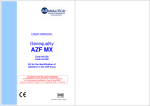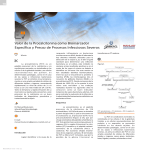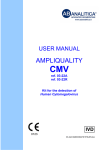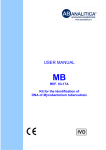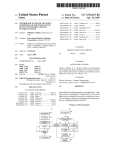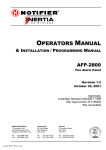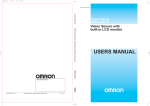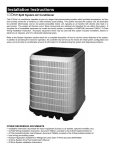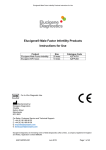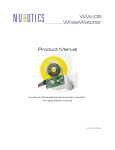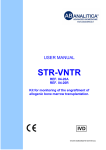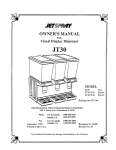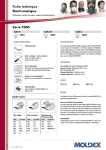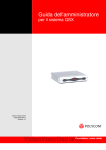Download AZF MX
Transcript
USER MANUAL Genequality AZF MX ref. 04-23C ref. 04-23A ref. 04-23R Kit for the identification of deletions in AZF locus Compliant to the European Guidelines “EAA/EQMN best practice guidelines for molecular diagnosis of Y-chromosomal microdeletions. State of the art 2004” Simoni M., Bakker E., Krausz C. Int. J. Andrology, 2004, 27: 240-249. 04-23A-25(8033622781004)-EN.doc 1 PRODUCT INFORMATION 3 2 KIT CONTENT 4 3 STORAGE AND STABILITY OF THE REAGENTS 6 4 PRECAUTIONS FOR USE 6 5 SAFETY RULES 7 5.1 General safety rules 7 5.2 Safety rules about the kit 8 6 MATERIALS REQUIRED, BUT NOT PROVIDED 10 6.1 Reagents 10 6.2 Instruments 10 6.3 Materials 10 7 PREPARATION OF THE REAGENTS 11 8 INTRODUCTION 12 9 TEST PRINCIPLE 15 10 PRODUCT DESCRIPTION 16 11 COLLECTION, MANIPULATION AND PRE-TREATMENT OF SAMPLE 17 12 PROCEDURE 17 12.1 DNA EXTRACTION 17 12.1.1 DNA extraction from fresh or frozen whole blood 18 12.2 DNA AMPLIFICATION 19 12.3 VISUALIZATION OF THE AMPLIFICATION PRODUCTS 20 12.3.1 High Resolution agarose gel electrophoresis 20 12.3.2 Sample loading 21 13 INTERPRETATION OF THE RESULTS 22 14 TROUBLESHOOTING 24 15 DEVICE LIMITS 27 pag.1 04-23A-25(8033622781004)-EN.doc 16 DEVICE PERFORMANCES 27 16.1 Specificity 27 16.2 Diagnostic sensitivity 27 17 BIBLIOGRAPHIC REFERENCES 28 pag.2 04-23A-25(8033622781004)-EN.doc 1 PRODUCT INFORMATION This user manual describes the instructions for use of the following products: AZF-MX COMPLETE (cod 04-23C) Complete system for the identification of deletions in the AZF locus, involved in male infertility. The kit includes all the reagents for DNA extraction, amplification and visualization by agarose gel electrophoresis, the internal control of sample amplificability and the reference DNA. Code 04-23C-12 04-23C-24 Product AZF-MX COMPLETE AZF-MX COMPLETE Pkg 12 test 24 test AZF-MX (cod 04-23A) Kit for the identification of deletions in the AZF locus, involved in male infertility. The kit includes the reagents for amplification and visualization by agarose gel electrophoresis, the internal control of sample amplificability and the reference DNA. Code 04-23A-12 04-23A-24 Product AZF-MX AZF-MX Pkg 12 test 24 test AZF-MX – amplification reagents (cod 04-23R) Kit for the identification of deletions in the AZF locus, involved in male infertility. The kit includes the reagents for amplification, the internal control of sample amplificability and the reference DNA. Code 04-23R-12 04-23R-24 Product AZF-MX – amplification reagents AZF-MX - amplification reagents Pkg 12 test 24 test pag.3 04-23A-25(8033622781004)-EN.doc 2 KIT CONTENT NOTE: In the kits with different codes (C,A or R) different components are included. (legenda: X = component included in the kit; 0 = component not included in the kit) BOX P cod. 04-23C cod. 04-23A cod. 04-23R STORE AT – 20°C DESCRIPTION LABEL TUBE (T) OR LID COLOUR 12 test 24 test X X X Single-dose premix tubes for Multiplex I. colourless (T) 12 24 X X X Single-dose premix tubes for Multiplex II. Blue (T) 12 24 X X X Single-dose premix tubes for Multiplex III. Yellow (T) 12 24 X X X Thermostabile Hot-start Taq DNA polimerase Super AB Taq 5 U/μL Red 1X 25 μL 1X 50 μL X 0 0 Protease Proteasi Green 3X 100 μL 6X 100 μL SMALL BAG cod. 04-23C cod. 04-23A cod. 04-23R STORE AT – 20°C X X X DESCRIPTION Reference DNA (from an undeleted male) LABEL TUBE (T) OR LID COLOUR 12 test 24 test Reference DNA (undeleted male) Blue 1X 20 μL 1X 40 μL pag.4 04-23A-25(8033622781004)-EN.doc BOX F cod. 04-23C cod. 04-23A cod. 04-23R STORE AT +2°/ +8°C X X DESCRIPTION 0 Electrophoresis loading buffer (6X solution) X X 0 Ethidium Bromide solution (2,5 mg/mL) X X 0 DNA Molecular Weight Marker (MW) LABEL TUBE (T) OR LID COLOUR 12 test 24 test Bromophenol blue Blue 1X 200 μL 1X 350μL Red 1X 100 μL 1X 180 μL Yellow 1X 100 μL 1X 180 μL Ethidium Bromide TOXIC R 23 68 S 36/37 45 MW Marker BOX A cod. 04-23C cod. 04-23A cod. 04-23R STORE AT +15°/ +25°C DESCRIPTION LABEL Agarose molecular biology grade TUBE (T) OR LID COLOUR 12 test 24 test AGAROSE 10 g 20 g 50 X TAE 40 mL 70 mL X X X X X X Electrophoresis buffer TRIS-Acetate -EDTA pH 8,0 X 0 0 Cell Lysing Solution SOLUTION 1 1X 3 mL 1X 6 mL X 0 0 Washing Solution SOLUTION 2 1X 11 mL 1X 22 mL X 0 0 Washing Solution SOLUTION 3 1X 10,5 mL 1X 21 mL X 0 0 Eluting Solution Eluting Solution 1X 3 mL 1X 6 mL X 0 0 Filter columns 12 24 X 0 0 2 mL tubes 24 48 pag.5 04-23A-25(8033622781004)-EN.doc 3 STORAGE AND STABILITY OF THE REAGENTS Each component of the kit should be stored according to the directions indicated on the label of the single boxes. In particular: Box P Small bag Box F Box A store at -20°C store at -20°C store at +2/+8°C store at +15/+25°C (room temperature) When stored at the recommended temperature, all test reagents are stable until their expiration date, indicated on the labels. 4 PRECAUTIONS FOR USE • The kit should be handled by investigator qualified through education and training in molecular biology techniques applied to diagnostics. • Before starting the kit procedure, read carefully and completely the instruction manual. • Keep the product out of heating sources; • Do not use any part of the kit if over the expiration date; • In case of any doubt about the storage conditions, box integrity or method application, contact AB ANALITICA technical support at: [email protected] before using the kit. In the amplification of nucleic acids, the investigator has to take the following special precautions: • Use filter-tips; pag.6 04-23A-25(8033622781004)-EN.doc • Store the biologic samples, the purified DNA, the reference DNA included in the kit and all the amplification products in different places from where amplification reagents are stored. • Organise the space in different pre- and post-PCR units; do not share consumables (pipets, tips, tubes,…) between them. • Change frequently the gloves; • Wash the bench surfaces with 5% sodium hypochloride; • Store the extracted DNA at +2° / +8°C for short term, or freeze them at -20°C for long term storage. • Thaw the PCR premixes at room temperature before use. Add Taq DNA polymerase and purified DNA very quickly at room temperature, better if in an ice-bath. 5 SAFETY RULES 5.1 General safety rules • Wear disposable gloves to handle reagents and clinical samples, wash your hands at the end of work. • Do not pipet with mouth. • Since no known diagnostic method can assure the absence of infective agents, it is a good rule to consider every clinical sample as potentially infectious and handle it as such. • All the devices that get directly in touch with clinical samples should be considered as contaminated and disposed as such. In case of accidental spilling of the samples, clean up with 10% Sodium Hypochloride. The materials used to clean up should be disposed in special containers for contaminated products • Clinical samples, materials and contaminated products should be disposed after decontamination by: pag.7 04-23A-25(8033622781004)-EN.doc immersion in a solution of 5% Sodium Hypochloride (1 volume of Sodium Hypochloride solution every 10 volumes of contaminated fluid) for 30 minutes OR autoclaving at 121°C at least for 2 hours (NOTE: do not autoclave solutions containing Sodium Hypochloride!!) 5.2 Safety rules about the kit The risks for the use of this kit are related to the single components: Dangerous components: ETHIDIUM BROMIDE (included in 04-23C and 04-23A) 3,8-diamino-1-ethyl-6-phenylphenantridiumbromide (Ethidium Bromide) <2% Description of risk: T (Toxic) RISK SENTENCES AND S SENTENCES R 23 and R 68 S 36/37 45 Toxic for inhalation. Risk of irreversible effects. Wear laboratory coat and disposable gloves. In case of accident or discomfort, seek for medical assistance and show the container or label. R and S sentences refer to the concentrated product, as provided in the kit. In particular for Ethidium Bromide, until the dilution in the agarose gel. In manipulating concentrated Ethidium Bromide, use a chemical dispensing fume cabinet. Always wear disposable gloves and laboratory coat in manipulating the diluted Ethidium solution as well. The product can not be disposed with the common waste. It must not reach the drainer system. For the disposal, follow the local law. In case of accidental spilling of Ethidium Bromide, clean with Sodium hypochloride and water. pag.8 04-23A-25(8033622781004)-EN.doc SOLUTION 1 and SOLUTION 2 (included in 04-23C) Solution 1 and 2 contain guanidinium hydrochloride Description of risk: Harmful and irritating RISK SENTENCES AND S SENTENCES R 22-36 and R 38 S 13-26-36-46 Toxic if swallowed. Irritating for skin and eyes. Store away of food and beverage. In case of contact with eyes, rinse immediately with plenty of water and seek medical advise. Use protective cloth and suitable gloves. In case of accident or discomfort, seek for medical advice immediately and show the container or label. PROTEASE (included in 04-23C) Description of risk: May cause sensitization, irritating. RISK SENTENCES AND S SENTENCES R 37 and R 38-41-42 S 24-26-36 S 37; S 46 Toxic if swallowed. Irritating for skin and eyes. Avoid contact with skin and eyes. In case of contact with eyes, rinse immediately with plenty of water and seek medical advise. Use protective cloth and suitable gloves. In case of accident or discomfort, seek for medical advice immediately and show the container or label. Safety data sheet (MSDS) of the kit is available upon request. pag.9 04-23A-25(8033622781004)-EN.doc 6 MATERIALS REQUIRED, BUT NOT PROVIDED 6.1 Reagents • • • • • Reagents for DNA extraction (necessary for cod. 04-23A and 04-23R) Sterile DNase and RNase free water; Distilled water; 96% – 100% Ethanol (necessary for the kit cod. 04-23C) Reagents for agarose gel electrophoresis (necessary for cod. 04-23R) 6.2 Instruments • Laminar flow cabinet (use is recommended while adding TAQ polymerase to the amplification premix to avoid contamination; it would be recommended to use another laminar flow cabinet to add the extracted DNA); • Micropipettes (range: 0,2-2 µL; 0,5-10 µL; 2-20 µL; 20-200 µL; 100-1000 µL); • Thermal cycler; • Thermoblock or thermal bath; • Microcentrifuge (max 12-14.000 rpm); • Balance; • Vortex; • Magnetic heating stirrer or microwave. • Chemical cabinet (its use is recommended in handling Ethidium Bromide); • Horizontal electrophoresis chamber for agarose minigel; • Power supply (50-150 V); • UV Transilluminator; • Photo camera or image analyzer. 6.3 Materials • Disposable gloves; • Disposable sterile filter-tips (range: 0,2-2 µL; 0,5-10 µL; 2-20 µL; 20-200 µL; 100-1000 µL) • Graduate cylinders (1 L) for of TAE dilution; • Pyrex bottle or Becker for agarose gel preparation; • Parafilm. • Microtubes (1,5 – 2,0 mL) pag.10 04-23A-25(8033622781004)-EN.doc 7 PREPARATION OF THE REAGENTS Preparation of 1 L of 1X TAE buffer: Mix 20 mL of 50X TAE with 980 mL of distilled water. pag.11 04-23A-25(8033622781004)-EN.doc 8 INTRODUCTION Nowadays, the analysis of microdeletions of Y chromosome is considered an essential diagnostic approach to study male infertility. Recent studies have divided the Y chromosome long arm into three regions, called AZF (Azoospermia Factors), frequently found to be deleted in some azoospermatic and serious oligozoospermatic subjects. These loci (AZFa, AZFb e AZFc) contain genes that control the correct course of spermatogenesis (Fig.1) Alterations in one or more AZF loci cause a drastic reduction of germinal cells up to their complete absence. Several studies marked the relation between the deletions and the presence of repeated DNA sequences showing that a recombinational event between the two proviral sequences is the basis of AZFa deletion (Kamp et al., 2000; Sun et al., 2000). AZFc deletions are generally more uniform and follow the recombination between blocks of repeated DNA sequences flanking the region. (KurodaKawaguchi et al., 2001). A diagnosis of Y-related infertility is suspected in males with serious Azoospermia or Oligozoospermia, associated with anomalous morphology and/or spermatic motility, in absence of other known causes. In 5 to 10% of these subjects microdeletions of Y chromosome are identified by molecular analysis. To evaluate the integrity of Y euchromatic region, at least four genes should be investigated: USP9Y (or DFFRY), DBY, RBMY and DAZ. These genes are currently considered to be directly or indirectly involved in male fertility. USP9Y is a single copy gene located in AZFa region, it has its homologous on the X chromosome and it is expressed ubiquitously. (Brown et al., 1998). DBY, located in AZFa region, is a single copy gene with an homologous on the X chromosome as well, but it gives a specific transcript at the testicular level (Lahn & Page, 1997). RBMY is a multicopy gene mainly located in AZFb region and expressed exclusively at testicular level (Ma et al, 1993). DAZ is a gene located in AZFc region in four copies arranged in two clusters (Saxena et al., 2000). Recently, PCR amplification of short DNA sequences (STS) within AZF loci has been recognised as the best method to detect microdeletions in these regions. pag.12 04-23A-25(8033622781004)-EN.doc Fig.1: SCHEMATIC VISUALIZATION OF Y CHROMOSOME AND AZF LOCI Markers for the detection of microdeletions in AZF locus. SRY ZFY AZFa sY86 sY84 DFFRY, in USP9Y gene DBY, in DEAD BOX Y gene sY95 AZFb AZFc sY117 sY125 sY127 sY134 sY254, in DAZ gene sY255, in DAZ gene Published data demonstrated that the routinely performed diagnostic protocols were very different and often leading to inaccurate or incomplete diagnosis. The need of standardization was highlighted in a preliminary publication of the European Guidelines that described the main characteristics of the amplification reaction and the markers required to have a complete and reliable diagnosis (Simoni et al., 1999). Four years after this preliminary publication, the complete sequencing of Y chromosome (Skaletsky et al., 2003) and the knowledge about the molecular mechanisms of deletions (Kampo et al., 2000; Sun et al., 2000; Repping et al., 2002) the new European Guidelines were published (Simoni et. Al., 2004). The European Guidelines give precise indications for the selection of the patients to be screened. The authors suggest. • • • A multiplex PCR amplification of genomic DNA must be performed. The amplification of the ZFX/ZFY gene is an appropriate internal PCR control because the primers amplify a unique fragment both in male and female DNA, respectively. The basic characteristics of the selected markers are: Y-specificity, absence of other homologous sequences, non-polymorphic. pag.13 04-23A-25(8033622781004)-EN.doc • At least two loci in each AZF region should be analysed: for AZFa: sY84, sY86 for AZFb: sY127, sY134 for AZFc: sY254, sY255 • The SRY gene should be included in the analysis as a control for the testis-determining factor on the short arm of the Y chromosome and for the presence of Y-specific sequences when the ZFY gene is absent (e.g. in XX males). pag.14 04-23A-25(8033622781004)-EN.doc 9 TEST PRINCIPLE PCR method (Polymerase Chain Reaction) has been the first method of DNA amplification described in literature. (Saiki RK et al., 1985). It can be defined as an in vitro amplification reaction of a specific part of DNA (target sequence) by a thermo-stable DNA polymerase. Three nucleic acid segments are involved in the reaction: double stranded DNA template to be amplified (target DNA) and two single-stranded oligonucleotides “primers” that are designed in order to anneal specifically to the template DNA. The DNA polymerase begins the synthesis process at the region marked by the primers and synthesizes new double stranded DNA molecules, identical to the original double stranded target DNA region, by facilitating the binding and joining of the complementary nucleotides that are free in solution (dNTPs). After several cycles, one can get millions of DNA molecules which correspond to the target sequence. The sensitivity of this test makes it particularly suitable for the application in laboratory diagnostics. The multiplex amplification allows the simultaneous amplification of different DNA sequences in the same reaction, by mean of a selected primers mix. pag.15 04-23A-25(8033622781004)-EN.doc 10 PRODUCT DESCRIPTION The amplification of short DNA sequences (STS) in AZF loci is the best method to verify the presence of microdeletions in Y chromosome. In particular, the strategy of the proposed method consists of the amplification of eleven markers by mean of 3 multiplex PCR. AZF MX method is compliant to the indications of the recently proposed European Guidelines for diagnostic testing of Y-chromosomal microdeletions (Simoni M et al., 2004) that define the basic characteristics of the primer set and of the amplification protocol to enable the detection of almost all the clinically relevant deletions. The amplification of the internal control (in the ZFX/ZFY gene) allows to verify the good quality of the extracted DNA and, at the same time, the absence of amplification inhibitors, avoiding false positive results. The kit includes reference DNA from a non-deleted male. The amplification of the reference DNA (with the presence of all the expected bands) is a guarantee of a correct course of the reaction. The reference DNA is of human origin but it is not dangerous for the operator. The kit is in premix format: all the reagents for the amplification are pre-mixed and aliquoted in monodose test tubes to which Taq polymerase and the extracted DNA will be added. This premix format allows the reduction of the manipulation in preamplification steps, with a considerable time saving for the operator, the repeated freezing/thawing of reagents (that could alter the product performances) is avoided and, above all, this form reduces at minimum the risk of sample contamination and the risk to get false positive results. Nevertheless, it is always recommended to use all the proper amplification controls. pag.16 04-23A-25(8033622781004)-EN.doc 11 COLLECTION, MANIPULATION AND PRETREATMENT OF SAMPLE The procedure for the analysis of microdeletions of Y chromosome starts from the collection of whole blood samples. The sample collection should follow all the usual sterility precautions. Blood should be treated with EDTA. Other coagulating agents, as heparin, are strong inhibitors of TAQ polymerase and so they could alter the efficiency of the amplification reaction. Fresh blood can be stored at +2 / +8°C for short time; if DNA is not extracted shortly, it is necessary to freeze the sample. 12 PROCEDURE 12.1 DNA EXTRACTION AB ANALITICA suggests the use of AZF MX COMPLETE kit (cod. 04-23C) that includes the extraction system, with which the method has been standardized. In any case, any DNA extraction method can be used, provided that allows the extraction of pure and integral DNA. Extracted DNA should be quantified by spectrophotometric measurement. The amount of DNA to be used in the amplification is 180 ng, therefore, the purified DNA solution should be diluted taking into account that the available volume in each premix tube is 6 μL. For any problem in method application you can contact AB ANALITICA technical support at: [email protected] . The extraction method below is referred to the kit AZF MX COMPLETE (cod 04-23C). pag.17 04-23A-25(8033622781004)-EN.doc 12.1.1 DNA extraction from fresh or frozen whole blood 1. Add 20 μL of Protease into a 1.5 mL tube. 2. Add 200 μL of fresh or frozen whole blood (treated with EDTA). 3. Vortex and mix the Solution 1; then add to the sample 200 μL of this solution. Mix by vortexing for 15 sec. 4. Incubate at 56°C for 10 min. 5. Centrifuge briefly to remove droplets from the inside of the lid; then add 200 μL of Ethanol (96%-100%) and mix by vortexing for 15 sec. 6. Centrifuge briefly; then transfer the mix into a filter column; close the cap and centrifuge at 8000 rpm for 1 min. 7. Transfer the filter column into a new 2 mL tube and discard the column containing the filtrate. 8. Open the cap of the filter column and add 500 μL of Solution 2; close the cap and centrifuge at 8000 rpm for 1 min. 9. Transfer the filter column into a new 2 mL tube and discard the column containing the filtrate. 10. Open the cap of the filter column and add 500 μL of Solution 3; close the cap and centrifuge at 14000 rpm for 3 min. 11. Transfer the filter column into a 1.5 mL tube, paying attention not to wet the lower part of the filter with the filtrate. If this happens centrifuge briefly. 12. Open the cap of the filter column and add 200 μL of the Elution Solution or sterile distilled water. Incubate for 1-5 min at room temperature and then centrifuge at 8000 rpm for 1 min. Extracted and purified DNA contained in the filtrate is stable for at least 1 year if stored at – 20° C. pag.18 04-23A-25(8033622781004)-EN.doc 12.2 DNA AMPLIFICATION For each sample, add to each premix tube: 0,2 µL 6 µL Super AB Taq extracted DNA It is important to include in each experiment a negative control to monitor the contamination (add distilled water to the mix instead of extracted DNA) and a reference DNA (DNA of a undeleted male) that will show all the bands of the different markers. Put the microtubes into the thermalcycler programmed as below: 1 cycle 94°C 5 min 94°C 1 min 60°C 1 min 72°C 1 min 1 cycle 72°C 7 min storage 4°C 40 cycles Tab. 1: Lenghts of the amplification products MX 1 bp MX 2 bp MX 3 bp ZFX/ZFY SRY sY254 sY86 sY127 sY255 495 472 380 320 274 120 ZFX/ZFY SRY sY95 sY117 sY125 495 472 303 262 200 DBY ZFX/ZFY SRY sY84 sY134 DFFRY 689 495 472 326 301 155 NOTE: The amplification of ZFX/ZFY gene is the internal PCR control because the primers amplify an unique fragment both in male and female DNA respectively. pag.19 04-23A-25(8033622781004)-EN.doc 12.3 VISUALIZATION OF THE AMPLIFICATION PRODUCTS 12.3.1 Agarose gel electrophoresis Preparation of a 3% agarose gel: Weight 1.5 g of supplied agarose powder and pour it into 50 mL of 1X TAE. Leave the solution on a magnetic stirring heater or in a microwave until the solution becomes clear. Allow the gel to cool for a few minutes (3-5 min), then add 10 µL of the Ethidium Bromide solution. CAUTION: Ethidium Bromide is a strong mutagenic agent: Always wear gloves and preferably work under a chemical safety cabinet during the handling of this reagent or gels containing it. Pour the gel into the appropriate gel casting tray, with the comb placed in and allow the gel to cool at room temperature or in a fridge until the gel becomes solid. Remove the comb carefully (pay attention to not damage the gel’s wells), transfer the tray into the electrophoresis chamber and pour the appropriate amount of 1X TAE buffer so that it covers the gel completely (about 1-2 mm over the gel surface). pag.20 04-23A-25(8033622781004)-EN.doc 12.3.2 Sample loading For visualization of the amplification products, mix into a tube or directly on a parafilm layer: 2 µL 10 µL 6X Blue* Amplification product of each multiplex PCR 2 µL 10 µL 6X Blue* DNA Molecular Weight Marker* and NOTE: 6X Blue* and DNA Molecular Weight Marker * are included in cod. 04-23A and 04-23C only; if other loading buffers or molecular weight markers are used, refer to the manufacturer’s instructions. Load the mixture in the gel wells; switch on the power supply and set the voltage between 80-90 V. Run the gel for about 2 hours, then place the gel on an UV transilluminator and analyze the results by comparing the size of the amplification products with the reference Molecular Weight Marker. * DNA Molecular Weight Marker (Marker MW): 501- 489, 404, 331, 242, 190, 147, 111, 110, 67, 34x2, 26 bp. (NOTE: In a 2.5% agarose gel the 501-489 bp bands usually are not clearly resolved and appear as an unique band; the 26 and 34 bp bands are sometimes too small to be visible in a 2.5% agarose gel (because of their low molecular weight). NOTICE: UV rays are dangerous for skin and, above all, eyes: always wear gloves and safety glass or make use of the protection screen of UV transilluminator. pag.21 04-23A-25(8033622781004)-EN.doc 13 INTERPRETATION OF THE RESULTS The included controls should show the following results: CONTROL RESULT INTERPRETATION reference DNA presence of all expected bands negative control absence of bands the The multiplex PCR amplification works correctly. Absence of contaminations Then the interpretation of the bands on agarose gel follows the table below: AZF MARKERS RESULT ZFX/ZFY band AZF markers absent absent (some or all of sample not amplificable* them) present amplificable sample, without any present deletion at the AZF locus, and present presence of the testis determining factor. present amplificable sample, without AZF absent locus and presence of the testis present determining factor (e.g XX-male). ZFX/ZFY band all AZF markers SRY band ZFX/ZFY band all AZF markers SRY band ZFX/ZFY band AZF markers INTERPRETATION present amplificabile sample, absent (one or more of deletions at the AZF locus. them) with *if the results show that the sample is not amplificable (absence of the band of the internal control ZFX/ZFY) the complete analysis should be repeated. The parallel amplification of the SRY marker and the internal control ZFX/ZFY allows the monitoring of any female contamination. pag.22 04-23A-25(8033622781004)-EN.doc MARKERS / INTERNAL CONTROL AZF MARKERS NOT-DELETED XY MALE XX MALE XX FEMALE DELETED XY MALE + + + -+ + -+ -- + / -+ + ZFX / ZFY SRY In case of absence of the band of one or more markers, it is suggested to repeat the amplification. 1 2 3 Fig 2. 2.5 % high resolution agarose gel electrophoresis of the three multiplex PCR amplifications. 1. 2. 3. 4. DNA Molecular Weight Marker Multiplex I Multiplex II Multiplex III The analysed patient is not deleted for any of the markers. For any problem you can contact AB ANALITICA technical support: e-mail: [email protected] fax N +39 049-8709510. pag.23 04-23A-25(8033622781004)-EN.doc 14 TROUBLESHOOTING Neither amplification products, nor reference DNA band • TAQ polymerase was not correctly added to the premix - Use pipets and tips of suitable volumes (pipet range 0,2 - 2 μL) and suitable tips. - Check visually that TAQ polymerase diffuses in the premix: this is easy because the enzyme is in dissolved glycerol that has a higher density. - Alternatively, put the drop of TAQ polymerase on the tube wall, then centrifuge briefly. • The thermalcycler was not programmed correctly. Check the conformity of the thermalcycler program and the temperature profile in the instruction manual. • The kit doesn’t work properly - Store the premixes, TAQ polymerase and reference DNA at -20°C; - Avoid repeated freezing and thawing of the reagents. No amplification bands (or only for some markers), absence of the ZFX/ZFY band, but a good band for reference DNA Possible problems during the extraction step: If you used the kit AZF MX COMPLETE (cod. 04-23C) please consult the table in the following page. pag.24 04-23A-25(8033622781004)-EN.doc Possible causes Comments and suggestions Inefficient cell lysis, due to an insufficient Repeat the extraction with a new sample; mixing of Solution 1 with the sample. pay attention to mix the sample with Solution 1 by vortexing. (Point 11, par. 11.1) Inefficient cell lysis, due to a decreased Repeat the extraction with a new sample protease activity. by using a new aliquot of Protease; avoid repeated freezing/thawing of the solution. Ethanol (96%-100%) was not added to Repeat correctly the extraction by starting the lisate before its transfer into the filter from a new sample. column. Leukopenic patient. Do not use whole blood, but enrich the leukocitary fraction of the sample (buffy coat, Ficoll-Hypaque). Ethanol (96%-100%) was not added to Repeat correctly the extraction by starting the lisate before its transfer into the filter from a new sample column (point 6, par.11.1) or a solution with a low percentage of Ethanol has been used. The filter column has not been incubated The filter column has to be incubated for at room temperature (+15°C/+25°C) for 1 at least 1 min at room temperature after min (point 12, par.11.1) adding the Elution Solution. DNA has not been efficiently eluted. In order to increase the efficiency of DNA elution, incubate the filter column at room temperature for 5 min. Solution 1 and 2 have not been correctly Verify that both the solutions have been used. employed in the correct order. Repeat the extraction by starting from a new sample. Elution with an excessive volume of Repeat correctly the extraction, starting Elution Solution. from a new sample. Presence of a little volume of DNA in the For a good result of the amplification eluate. reaction the DNA amount has to be 180 ng. If the concentration of eluted DNA (revealed with spectrophotometric measures) is too low, it is suggested to repeat the extraction, and elute in less than 200 μL volume. Note that decreasing the elution volume to <200 μL, DNA concentration increases in the eluate, but the total yield may be reduced. pag.25 04-23A-25(8033622781004)-EN.doc In case you used the kit AZF MX cod. 04-23A and following points and proceed as suggested: • • • 04-23R, verify the Verify that you followed very careful the manufactures’s instructions of the extraction kit. Consult the “troubleshooting” section of the user manual of the extraction kit. Repeat the DNA extraction from a new sample. Some inhibitors or other factors which interfere with amplification reaction are present. • The obtained DNA solution is not pure (the ratio A260/A 280 is low).Verify to have correctly followed the extraction protocol and repeat the extraction by starting from a new sample; • In the obtained DNA solution there is residual RNA (the ratio A260/A 280 is too high) which can be eliminated by introducing a digestion step with RNAase. In case you used the kit AZF MX COMPLETE cod. 04-23C: • If the lower part of the filter has been wetted with the filtrate of Solution 3 (Point 14, par 11.1), transfer the filter column in a new 2 mL tube and centrifuge at 14000 rpm for 1 min. • Verify that Solutions 2 and 3 have been employed in the correct order, as indicated in the protocol. For any problem you can contact AB ANALITICA technical support: e-mail: [email protected] pag.26 04-23A-25(8033622781004)-EN.doc 15 DEVICE LIMITS The kit can have reduced performances if the clinical sample is not suitable for this analysis (blood sample non properly stored or treated with heparin as anti-coagulant) 16 DEVICE PERFORMANCES 16.1 Specificity The primers used in this method were studied in a way that they do not amplify repeated sequences in the chromosome or DNA sequences that have big nucleotidic differences among the population. Primer sequence alignment in the most important databanks shows the absence of unspecific alignment. Moreover, experimental data (total absence of feminine DNA amplification) revealed that the primers used for each marker are Y-specific. 16.2 Diagnostic sensitivity The use of a basic set of STS primers, as suggested in the European Guidelines (Simoni et al., 2004) enables the detection of almost all the clinically relevant deletions and over 95% of the deletions reported in literature in the three AZF loci. pag.27 04-23A-25(8033622781004)-EN.doc 17 BIBLIOGRAPHIC REFERENCES Brown GM, Furlong RA, Sargent CA, Erickson RP, Longepied G, Mitchell M, Jones MH, Hargreave TB, Cooke HJ, Affara NA. Hum Mol Genet. Jan;7(1):97-107, 1998 Kamp C, Hirschmann P, Voss H, Huellen K, Vogt PH., Hum Mol Genet. Oct 12;9(17):2563-72, 2000. Kuroda-Kawaguchi T, Skaletsky H, Brown LG, Minx PJ, Cordum HS, Waterston RH, Wilson RK, Silber S, Oates R, Rozen S, Page DC, Nat Genet. Nov;29(3):279-86, 2001. Lahn BT, Page DC, Science. Oct 24;278(5338):675-80, 1997 Ma K, Inglis JD, Sharkey A, Bickmore WA, Hill RE, Prosser EJ, Speed RM, Thomson EJ, Jobling M, Taylor K, Cell. Dec 31;75(7):1287-95, 1993 Saiki RK, S Scharf, F Faloona, KB Mullis, GT Horn, HA Erlich and N Arnheim, Science 230, 1350-1354, 1985. Saxena R, de Vries JW, Repping S, Alagappan RK, Skaletsky H, Brown LG, Ma P, Chen E, Hoovers JM, Page DC, Genomics. Aug 1;67(3):256-67, 2000 Simoni M., Bakker E., Eurlings M. C. M., Matthijs G., Moro E., Muller C. R. et Vogt P. H., Int. J. Andrology, 1999; 22:292-299. Simoni M., Bakker E., Krausz C. Int. J. Andrology, 2004, 27: 240-249. Sun C, Skaletsky H, Rozen S, Gromoll J, Nieschlag E, Oates R, Page DC., Hum Mol Genet., Sep 22;9(15):2291-6. 2000 Vogt P.H., Edelmann A., Kirsch S.; Hum. Mol. Genet., 5:933-943, 1996 pag.28 04-23A-25(8033622781004)-EN.doc t AB ANALITICA srl Via Svizzera 16 - 35127 PADOVA, (ITALY) Tel +39 049 761698 - Fax +39 049 8709510 e-mail: [email protected]
































